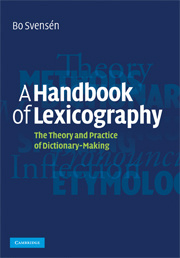Description
A Handbook of Lexicography
The Theory and Practice of Dictionary-Making
Author: Svensén Bo
An important and practical guide to the theory and methods of dictionary-making.
Language: English
Subject for A Handbook of Lexicography:
Approximative price 135.96 €
Subject to availability at the publisher.
Add to cart
A handbook of lexicography: the theory and practice of dictionary-making
Publication date: 08-2009
552 p. · 17.9x25.5 cm
Publication date: 08-2009
552 p. · 17.9x25.5 cm
Approximative price 62.49 €
Subject to availability at the publisher.
Add to cart
A handbook of lexicography: the theory and practice of dictionary-making
Publication date: 08-2009
552 p. · 17.3x24.7 cm
Publication date: 08-2009
552 p. · 17.3x24.7 cm
Description
/li>Contents
/li>Biography
/li>
This book provides a systematic survey of the theory and methods of dictionary-making: what types of dictionary there are, how different kinds of information are dealt with when compiling dictionaries, how this information is presented to users, and how dictionaries are actually used. It refers throughout to both monolingual and bilingual dictionaries, giving a full account of the writing of definitions as well as of the selection and presentation of equivalents. The treatment of other types of information provided in dictionaries is described systematically in individual chapters. The book also discusses dictionary structure, illustrations, the collection and selection of material, the management of dictionary projects, law and ethics in lexicographic work, and dictionary criticism. As well as looking at print lexicography, the author discusses the role of the Web, electronic corpora, electronic dictionaries, and compilation software used in dictionary-making. This is an important and practical guide to contemporary lexicography, designed for lexicographers, language students and teachers, translators and academics.
1. Lexicography; 2. Types of dictionaries; 3. Data collection and data selection; 4. The dictionary as text; 5. The lemma; 6. Spelling and word division; 7. Pronunciation; 8. Morphology; 9. Part-of-speech membership; 10. Constructions; 11. Collocations; 12. Idioms and other fixed word combinations; 13. Meaning description in monolingual dictionaries; 14. Equivalents in bilingual dictionaries; 15. Examples; 16. Encyclopedic information; 17. Illustrations; 18. Marking; 19. Etymology; 20. Microstructure; 21. Macrostructure; 22. Megastructure; 23. Cross-reference structure; 24. Dictionary projects; 25. Legal and ethical aspects; 26. The electronic dictionary; 27. Dictionary use; 28. Dictionary criticism.
Bo Svensén is a lexicographer, terminologist and philologist. He studied Latin, Greek and French at Stockholm University and has worked as an editor for various academic publishers.
© 2024 LAVOISIER S.A.S.




